Introduction
Sixty-six million years ago a worldwide cataclysmic event marked the end of the Mesozoic Era and changed the whole course of life on earth (Fig. 1). This was the end-Cretaceous mass extinction, and whether it was caused by a bolide strike or triggered by huge volcanic eruptions remains hotly debated. There is geological evidence for both at the time. The outcome, however, is indisputable. The dinosaurs that had dominated the land vertebrate fauna for the previous 125 million years completely and abruptly disappeared, along with the related flying pterosaurs, and the great marine reptiles, the ichthyosaurs, plesiosaurs and others. The vertebrate survivors included birds (which are technically miniature, feathered, flying dinosaurs) and the crocodiles, lizards, snakes and turtles. All of these groups soon proceeded to diversify, although none of them underwent any great evolutionary transformations in body form. A small number of the pre-existing mammals also survived the extinction, but their story was very different. Over the course of the following 66 million year Cenozoic Era, an astonishing array of entirely new kinds of mammals soon evolved. Small, nocturnal ancestors gave rise to numerous large bodied herbivores such as antelopes, camels, hippos, horses, rhinoceroses, kangaroos, and elephants, along with the carnivorous cats, wolves, bears, and hyaenas that preyed upon them. Completely novel forms such as anteaters with long sticky tongues and powerful digging claws, and monkeys, apes and sloths adapted for life in the trees evolved, and within just 25 million years the most specialised mammal groups of all appear in the fossil record: the bats are as accomplished fliers as birds, and the whales and dugongs are superbly adapted physiologically and anatomically for a permanent life in the sea.
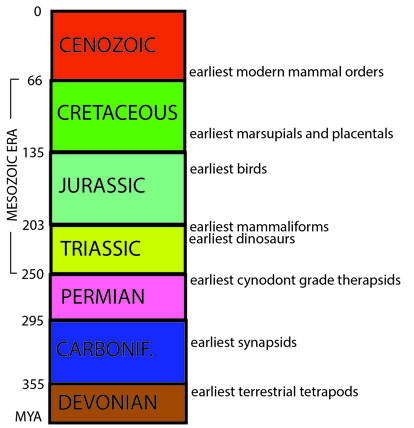
Origin of mammals
Thus the modern mammalian fauna evolved from a few end-Cretaceous survivors and replaced the dinosaurs as the dominant terrestrial animals. What is less widely appreciated is that this spectacular radiation of mammals over the last 66 million years was only the final one-third of a history we can trace all the way back to 200 million year old fossilised mammals of uppermost Triassic age. Furthermore, the Mesozoic mammals were themselves the culmination of a long, evolving lineage of more reptile-like forms called synapsids, as revealed to us by an extraordinarily good fossil record (Figure 2). The first synapsids lived about 320 million years ago and are distinguished by only a few characters from other rapidly diversifying tetrapods in the warm, humid climate of the time. But they rapidly became the most widespread and abundant group.
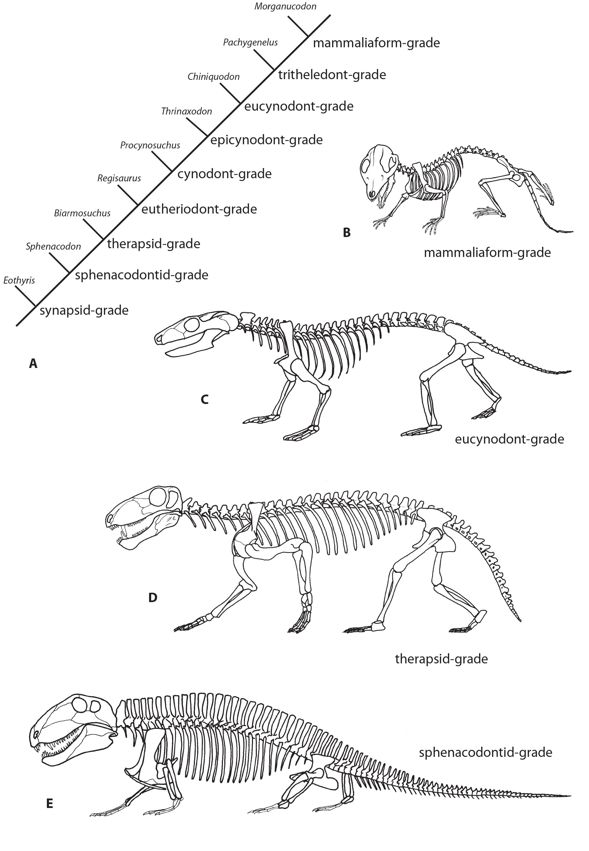
A range of different types evolved - carnivores to herbivores, large bodied to small bodied. Dicynodonts, for example, were specialised herbivores in which the teeth were replaced by a horny, grinding or chopping beak. There were many species and they often occurred in great abundance. Preying upon them were, among others, the gorgonopsians characterised by enormous upper and lower canine teeth and a huge gape of the jaws.
Over time synapsids evolved characteristics indicating that their metabolic rate and level of activity was increasing, and by the start of the Triassic, 250 million years ago, a progressive group called cynodonts (Fig. 2A and 3) possessed a mammal-like dentition of simple incisors and canines at the front of the jaws, and larger, multi-cusped teeth at the back. The jaw closing muscles were larger, and arranged so that most of the bite force was concentrated at the points of contact between the upper and lower teeth. Their rib cage shows that they had larger lungs, and the longer, more slender limbs that their locomotion was faster and more agile. The senses of smell and hearing were more acute, and the brain larger.

Over time, the cynodonts gradually became very mammalian in their biology. Some were herbivorous, some carnivorous, and one particular branch, the tritheledonts (Fig. 2A), evolved a small, typically rodent sized body.
It was from this last group that mammals finally evolved, and by the end of the Triassic, about 200 million years ago, fossils are found that are mammalian in virtually all respects (strictly speaking, they lack a few minor characters of living mammals and are properly classified as mammaliaforms). Megazostrodon, for example (Fig. 4), was about 10 cm long excluding the tail, with a 2 cm long skull. Its teeth consisted of incisors, a canine, four to five premolariforms with an extra cusp at the back of the tooth, and three elongated molariform teeth bearing extra cusps in front of and behind the main cusp and a circle of small cuspules around the base. The three main cusps were connected by sharp ridges, and when lower and upper molars met during the bite, the crests acted as cutting blades that finely shredded the food. The skeleton of Megazostrodon shows us that it was a very agile little animal, with slender limbs and feet positioned below the body. The brain was enlarged and included a large cerebellum for fine neuromuscular control of the body, and a large forebrain associated with complex behaviour. There were well developed olfactory lobes for smelling, and delicate ear ossicles capable of very sensitive hearing. From these indirect signs of its biology, we can infer that Megazostrodon, like modern mammals, had a highly energetic lifestyle, and was able to keep its body temperature constant allowing it to remain active at night. Judging from the sharp, cutting molar teeth, its main food was undoubtedly insects.
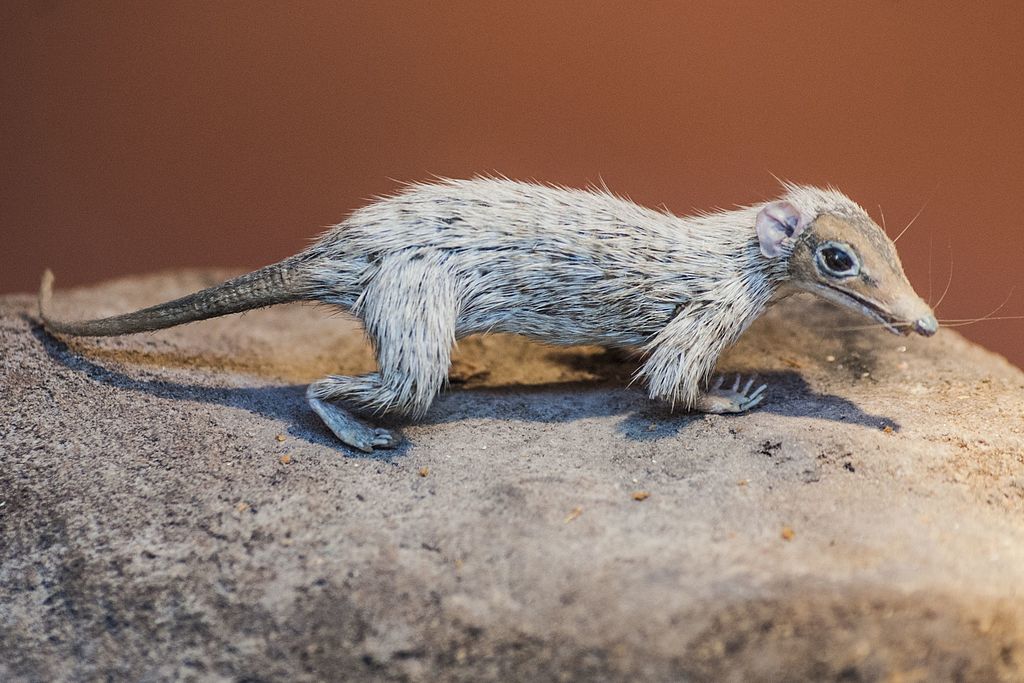
Discovery of Mesozoic mammals
The first Mesozoic mammal discoveries were from the Middle Jurassic Stonesfield Slate of Oxfordshire, which was quarried for roofing during the 18th and the 19th centuries. The fossils were exceedingly rare, and over the course of about 150 years, only twelve specimens were ever found in the thousands of tonnes of slate exposed, and these were no more than broken jaws with a few teeth, plus a couple of isolated limb bones. In due course several other sites in Europe and North America yielded Mesozoic mammals, but even by the late 1920s George Gaylord Simpson was able to personally study the entire world’s collection, which still consisted entirely of fragments. On the fossil evidence available at this time, mammals were regarded as extremely rare during the Mesozoic, of little ecological importance compared to the dinosaurs, and undergoing little significant evolution.
This picture started to change as more, and better preserved specimens were found in several parts of the world. In the 1960s Zofia Kielan-Jaworowska led a series of Polish-Mongolian expeditions to the Gobi Desert and collected a rich fauna of Early Cretaceous mammals, including several complete skulls and skeletons. In 1970s Britain, thousands of fragments of jaws, teeth, vertebrae and limb bones were discovered in ancient fissures of limestone quarries. These proved to be the remains of the earliest, Upper Triassic mammals that had got washed into underground watercourses of the day. Even more spectacular are the Chinese collections from the Upper Jurassic Tiaojishan and Early Cretaceous Yixian Formations. From the 1990s onwards and still continuing, these have yielded a large range of beautifully preserved specimens, some even including impressions of the pelt surrounding the skeleton (see Fig. 11).
Radiation of Mesozoic mammals
From these and many other new discoveries world-wide, we now have over three hundred genera of Mesozoic mammals. It has become clear that the Jurassic and Cretaceous forests, hills and plains teemed with mammals, much as they do today except that they were all small-bodied, the great majority under 1 kg and very few indeed exceeding the 5 kg of a Virginia opossum or red fox. We have also learned from the wealth of new specimens that a lot more evolutionary change and diversification took place than we had believed. Differences in the dentition point to a variety of dietary specialisations, and adaptation to several different habitats is indicated by the skeleton.
In fact, mammals had already commenced an evolutionary radiation at their first appearance in the Late Triassic. The morganucodonts such as Megazostrodon were the least modified, but at least two other groups had evolved more specialised molar teeth. The molar teeth of Kuehneotherium have three main cusps forming a triangle on the crown, and so when the jaws close, the lower and upper tooth rows interlock more firmly. We know nothing of the rare Kuehneotherium beyond its teeth and jaws, but this kind of triangulated tooth was to become very important in later groups. Haramiyids were the first group of mammals to evolve teeth adapted for chewing high energy plant food such as seeds and storage tubers, a theme recurrent throughout mammalian history and represented by the rodents today. Their molar teeth were enlarged and carried rows of rounded cusps, two on the lowers and three on the uppers, which interlocked to form a grinding surface. A fourth kind of Mesozoic mammal appeared soon after these. They were the docodonts, whose molar teeth were also enlarged, but in their case so as to expand the cutting action between crests. A broad expansion of each upper molar bit between two adjacent lower molars, giving a shearing action between the opposing teeth. The docodonts underwent a modest radiation that included different modes of locomotion. Some were adept trees dwellers, and one remarkable form, Castorocauda (Fig. 5), had a beaver-like flattened tail for swimming, and must have led a semi-aquatic existence.
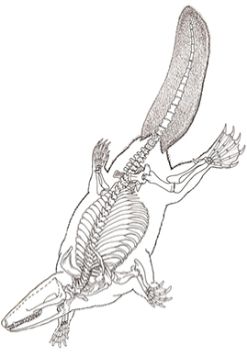
The multituberculates, like the haramiyids before them, were comparable to small rodents. They had a single, large incisor (Fig. 6) for grubbing around for food such as underground tubers. Behind it was a relatively huge, ridged, hatchet-like premolar tooth that chopped against the upper teeth. The upper and lower molars were somewhat like those of the haramiyids, bearing rows of blunt cusps that worked together to finely grind up the food.
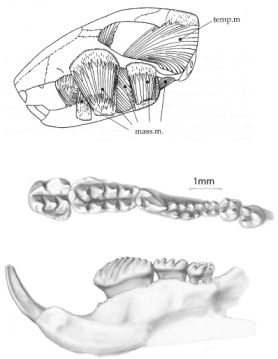
Multituberculates were the most successful of all the Mesozoic mammal groups with over 150 genera described, and they were also one of the groups that survived the end-Cretaceous mass extinction, lasting for about 35 million years into the Cenozoic. Some specimens have been found with the impression of a hairy pelt, showing they possessed mammalian endothermy. Less expected is a very narrow pelvic gap, suggesting that they bore their young live rather than laying eggs. Although their dentition was fairly conservative, multituberculates had a range of modes of locomotion (Fig. 7). They included conventional ground walking species, squirrel-like tree climbers, jumpers with longer hindlegs, and some have broad limb bones suggesting they may have been burrowers. Despite the diversity, no multituberculate has been found with a body size greater than about 0.5 kg.
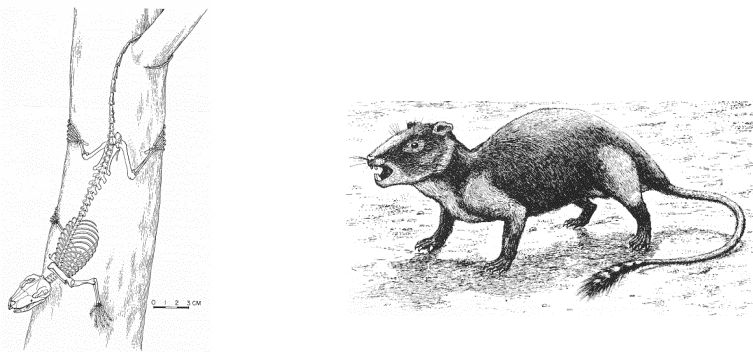
The eutriconodonts were the most important group of carnivorous mammals of the Mesozoic (Fig. 8). Their molar teeth bore a row of three or four sharp pointed cusps with crests between, for masticating living prey. Most species were small and fed on invertebrates, but a few were larger, such as Triconodon which was the size of a domestic cat, and would have been able to feed on lizards and other small mammals. The largest eutriconodont, and in fact the largest of all Mesozoic mammals was Repenomamus giganticus (Fig. 8). It was about a metre in length including the tail, and is estimated to have weighed 12-14 kg, about the size of a European badger. If there are any doubts about its diet, these are dispelled by the discovery of the remains of a juvenile dinosaur in its body cavity.

Most eutriconodonts were terrestrial, and some perhaps were arboreal, but they also include the remarkable Volaticotherium. The fossil specimen of this has the distinct impression of a gliding membrane preserved around the body, looking rather like that of a flying squirrel. At the other extreme, Fruitafossor is a basal triconodont possessing short, powerful, mole-like forelimbs for burrowing.
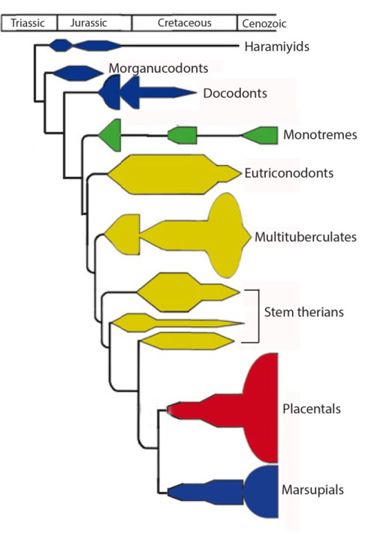
The emergence of the modern mammal groups
We have already met Kuehneotherium, the earliest Mesozoic mammal to have a triangle of cusps on the molar teeth. From the Middle Jurassic onwards, one group of mammals, called the Cladotheria, evolved increasingly elaborate versions by adding additional cusps and ridges to the molar crown (Fig. 10). The trend culminated in teeth known as tribosphenic, in a group of mammals aptly called Tribosphenida, in which the lower molars had a basin-shaped addition at the back called the talonid; the upper molars matched this by a large additional region on the inner side called the protocone. The effect was twofold. First, the teeth had a broader area of crown for a more effective general crushing action between lowers and uppers. Second, there was an increase in the number of opposing lower and upper cutting crests for finely shredding the food.
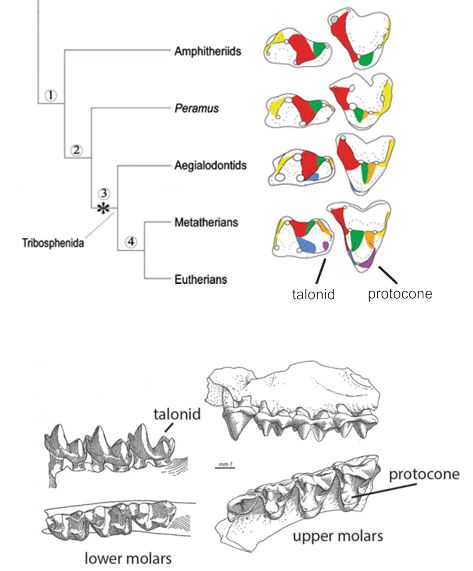
By the Early Cretaceous, a radiation of mammals with this kind of tooth was already underway, which coincided with the start of an explosive radiation of the flowering plants, and with it a plethora of insects that fed and lived on them. With their small size, and sharp cutting and mashing teeth, these new mammals were especially well adapted for efficiently chewing up insects. Amongst the fossils of the several early lineages of the tribosphenidans are two remarkable specimens from China. Eomaia (Fig. 11) is a virtually complete eutherian, the ancestral group of the living placental mammals. Its contemporary, Sinodelphys, is an equally well-preserved metatherian, the equivalent ancestral group of the second main modern mammal group, the marsupials. From this first appearance 125 million years ago, these two groups of mammals continued to evolve for the remainder of the Mesozoic, and of course to survive the end-Cretaceous mass extinction and give rise to almost every mammal species alive today.
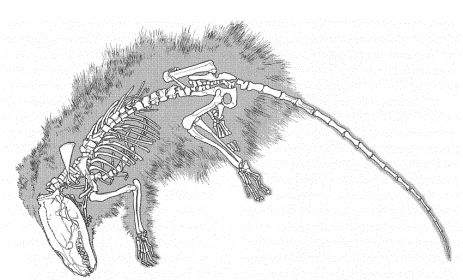
The third modern group of mammals are the monotremes, which consist solely of the echidnas and platypus of Australasia. Although fundamentally the same as other mammals, they have kept a few ancestral characters, notably the egg-laying habit. But the monotremes are so specialised in their teeth and limbs, and their fossil record is so poor, that the origin of the group is still obscure. A few fragmentary Early Cretaceous fossils suggest that an early mammal somehow dispersed into the southern continents, where it gave rise to a distinct new group with superficially tribosphenic-like teeth. The monotremes are supposedly highly specialised living descendants of this ancient group.
An overview of Mesozoic mammals
Our perspective of the mammals of the Jurassic and Cretaceous has radically shifted over the last three or four decades, from regarding them as an insignificant group living in the shadow of the dinosaurs to one whose diversity and abundance was comparable to the small mammal fauna today. There were species feeding on small invertebrates, on small reptiles and other mammals, and on high energy plant foods. There were ground and tree dwellers, specialist burrowers and semi-aquatics, and even gliders. However, the one great difference from the modern fauna is the conspicuous absence of mammals of medium and large body size (Fig. 12). The explanation for this is assumed to be competition from dinosaurs. Dinosaurs and mammals appeared at about the same time in the fossil record, so it was not simply that dinosaurs had already filled up the large land animal habitat by the time mammals arrived on the scene. We have to look further back and note that the mammalian body plan evolved essentially for a nocturnal, insectivorous life by miniaturisation of one of the synapsid lineages. In contrast, the dinosaur body plan evolved from a lineage of large archosaurs for a diurnal life. With both taxa well adapted for their respective way of life, neither could successfully overcome the competition in order to enter the adaptive zone of the other. Not, that is, until the end-Cretaceous mass extinction removed the dinosaurs, leaving the surviving mammals free to evolve a larger body size and adopt the diurnal herbivore and associated large carnivore modes of life, without competition from existing incumbents.
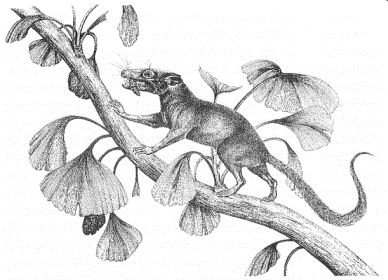
Want to know more?
- Kemp TS (2015) The Evolution of Higher Taxa: Palaeobiological, Developmental, and Ecological Perspectives Oxford University Press
- Luo Z-X (2007) Transformation and diversification in early mammal evolution Nature 450: 1011-1019.
- Kemp TS (2005) The origin and evolution of mammals Oxford University Press
- Kielan-Jaworowska Z, Cifelli RL, and Luo Z-X (2004) Mammals from the Age of Dinosaurs: Origins, Evolution, and Structure Columbia University Press
 Paleobiology
Paleobiology
Responses